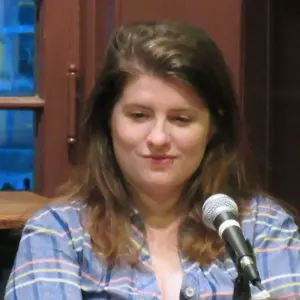It’s good to be a beloved writer, sure, but it’s even better to be making money off your writing. Yes, this is an obvious statement to make, yet that whole income thing can be a very difficult hurdle to overcome. Which is surely one of the reasons why Mallory Ortberg–one of the cofounders of the popular but now defunct website The Toast–decided to move her newsletter off the platform TinyLetter and onto a new one that will give her the option to monetize her content.
“It’s always great to be like, ‘Oh, I’m making money now,'” Ortberg tells me. For the last eight months, Ortberg has been sporadically writing down her thoughts to a voracious group of subscribers. It started last March, when she was finishing up her latest book. She thought it would be nice to have a more frequent outlet to post her thoughts. Thus, the new project was born.
Ortberg’s newsletter, called the Shatner Chatner, seems very much like a continuation of The Toast and its irreverent tone. It’s a whimsical trip into the writer’s mind. Her usually weekly emails feature essays, thoughts, jokes, et cetera, about any ol’ random subject–be it Star Trek, children’s literature, or ultimate frisbee. Ortberg admits it’s very much like The Toast, with even some of its recurring pieces–including, my personal favorite, her imagined conversations between Joan Didion and Anna Wintour. But it’s also hers and only hers. “It’s a little more introspective, a little more sensitive,” Ortberg says of the Shatner Chatner. “It’s Ortberg unplugged.”
Maxing Out Quickly
The thing about Mallory Ortberg is that she’s a very popular writer. Those who loved her daily musings on The Toast have long been looking for other ways to consume her work. While she freelance writes for many publications, it isn’t the same as when she had her own blog to write whatever she wanted, whenever she wanted.

Even so, Ortberg wasn’t getting paid for this work. It was just a nice way for her to connect with her readers; she describes the newsletter as tricking one’s self into thinking “Oh, we’re just having a conversation” (which I think is a really apt description of the best newsletters). With Shatner Chatner hitting this wall, she was faced with a choice: She could either stick with Tinyletter and her capped-out audience, or move to a more souped up service like MailChimp, for which she would have to pay.
It turns out there was a third option: The new service Substack offers a platform for newsletter writers to both publish content and sell subscriptions. The company, which takes a 10% cut of the subscriptions, has spent the last few months soliciting individual writers to test it out. Most recently, it inked a deal with the China-related newsletter Sinocism.
Substack’s founders contacted Ortberg, and she loved the idea. “When they said newsletters are a thing now–people are paying for them–it made a lot of sense,” says Ortberg. Her alternative, she realized, would be continuing doing it for free until she no longer had the time. “If you run out of time, the thing you get rid of is the thing you’re doing for free.” But the idea of giving people the option to subscribe for $5/month made the newsletter into a more viable project should could spend time on. The newsletter migrated to the new platform yesterday.
Ortberg realizes not everyone will shell out the money. “I’m sure there’s going to be lots of people [who say] ‘I liked getting it for free–good day to you, be well,'” she says. But given how many people initially signed up for Shatner Chatner, I imagine a real audience of paying subscribers will emerge. Ortberg adds that there will still be free content available on the website.
An Alternative To Scale
In some ways, this could be indicative of a necessary shift in online media. The most anticipated and well-funded players in the space are either being sold or not scaling fast enough. The industry as a whole is facing difficulties figuring out a model that pays talent. The problem is that media companies try to follow the ad dollars, and these sources of revenue are being controlled by a Facebook/Google duopoly, which puts the industry in a squeeze. Many are “pivoting to video” or making some other rash decision, which historically has led to writers losing their jobs.
Focusing not on scale but on individual creators is one way to avoid this peril of the ad-based model. “Small-scale subscriptions are having a moment,” says Ortberg. “It was really cool to hear that there is someone working on this.” Of course, only those with ravenous audiences like Ortberg have bat’s chance in hell of making this model work. Lucky for her, she does.
And so this move is a big experiment in how to circumvent the digital media crisis and figure out something that could at least be sustainable for the time being—although, in some ways, this is putting a Band-Aid on a gaping wound. Ortberg adds, “What I wish would happen is that all workplaces unionize. And there would be jobs with benefits and security. That would be the goal.”
“That said, I do think it’s really wonderful to be able to focus on finding your audience,” she adds. That is, “providing stuff for people who really like the work you do, and not spend as much time sending out those freelancer emails.”
Sounds like a writerly dream.
Recognize your brand’s excellence by applying to this year’s Brands That Matter Awards before the early-rate deadline, May 3.
